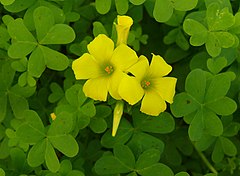Oxalis pes-caprae
| Oxalis pes-caprae subsp. var. | Bermuda buttercup, Bermuda sorrel, Buttercup oxalis, Goat's-foot, Sourgrass, Soursop | |||||||||||||||||||||||||||||||||||||||||||||||||||||||
|---|---|---|---|---|---|---|---|---|---|---|---|---|---|---|---|---|---|---|---|---|---|---|---|---|---|---|---|---|---|---|---|---|---|---|---|---|---|---|---|---|---|---|---|---|---|---|---|---|---|---|---|---|---|---|---|---|

|
|
| ||||||||||||||||||||||||||||||||||||||||||||||||||||||
| ||||||||||||||||||||||||||||||||||||||||||||||||||||||||
Oxalis pes-caprae (Bermuda buttercup, African wood-sorrel, Bermuda sorrel, Buttercup oxalis, Cape sorrel, English weed, Goat's-foot, Sourgrass, Soursob, Soursopis a species of flowering plant in the wood sorrel family Oxalidaceae. Oxalis cernua is a less common synonym for this species.
The flower is actinomorphic, with a calyx composed of five free or slightly fused sepals, a sympetalous corolla composed of five fused petals, an apoandrous androecium composed of ten free stamens in two ranks, and a compound pistil.
Indigenous to South Africa, Bermuda buttercup is a highly invasive weed in many parts of the world.[1] It is often called by the common name sourgrass or soursob due to its pleasant sour flavor. This sourness is caused by oxalic acid, which is toxic in large quantities and may contribute to kidney stones.
| Standard Cyclopedia of Horticulture |
|---|
|
Oxalis cernua, Thunb. (Bolboxalis cernua, Small). Bermuda Buttercup. Lvs. ascending, not very large or fleshy, often purplish or mottled; lfts. obcordate: fls. bright yellow. Cape.—A form with double fls. is var. plena
|
Cultivation
Propagation
Pests and diseases
Varieties
Gallery
References
- Standard Cyclopedia of Horticulture, by L. H. Bailey, MacMillan Co., 1963
External links
- w:Oxalis pes-caprae. Some of the material on this page may be from Wikipedia, under the Creative Commons license.
- Oxalis pes-caprae QR Code (Size 50, 100, 200, 500)



